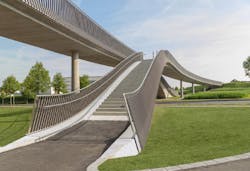Connecting the old & new at the University of Würzburg
Compared to other bridges, pedestrian bridges have it easy. After all, people are nowhere near as heavy as motor vehicles, tractor-trailers or trains. Because pedestrian bridges are built to bear smaller, lighter loads, architects and engineers are able to achieve an altogether different vision—with a little help from technology.
One such bridge is at the University of Würzburg in Germany. The new university campus, Hubland North, is located on a former U.S. military base—the Leighton area. After U.S. forces left in 2009, the state of Bavaria commissioned the construction of a pedestrian and bicycle path bridge between the old and new campus, to keep the nearby flow of cars unimpeded by student foot traffic and pedestrian crossing. The team of Dr. Schütz Ingenieure (Kempten), Kolb Ripke Architekten and POLA Landschaftsarchitekten (both Berlin) created a design that was implemented in a single-stage realization competition at the end of 2012.
With a total length of 358 ft, the Würzburg bridge incorporates a sloping arch with a short staircase and long ramp on each side, giving the perception of wave-like motion, similar to a sinusoidal curve. The semi-integral arched bridge, with its 11-ft-wide reinforced concrete bands, has a delicate aesthetic and fits seamlessly into the green landscape. The tilted steel railings contribute to the flowing aesthetic, with LED lights installed into the handrails for nighttime use.
From the 3D model to the concrete reinforcements, the pedestrian bridge was created with the help from Allplan’s parametric bridge modeling solution, allowing for better data projection and control laying the iron before construction. In the process, the 3D modeling of reinforcement drawings contributed to clarity and accuracy. Thanks to the existing terrain, a simple terrain model was created within a very short period of time. The parametric model allowed engineers to consider alignment, road profiles and complex geometries, and even suitable materials. Even complex geometries, including double curved alignment and variable cross-sections, can easily be created with the help of alphanumeric entries and stored formulas, making model configuration quick and efficient.
